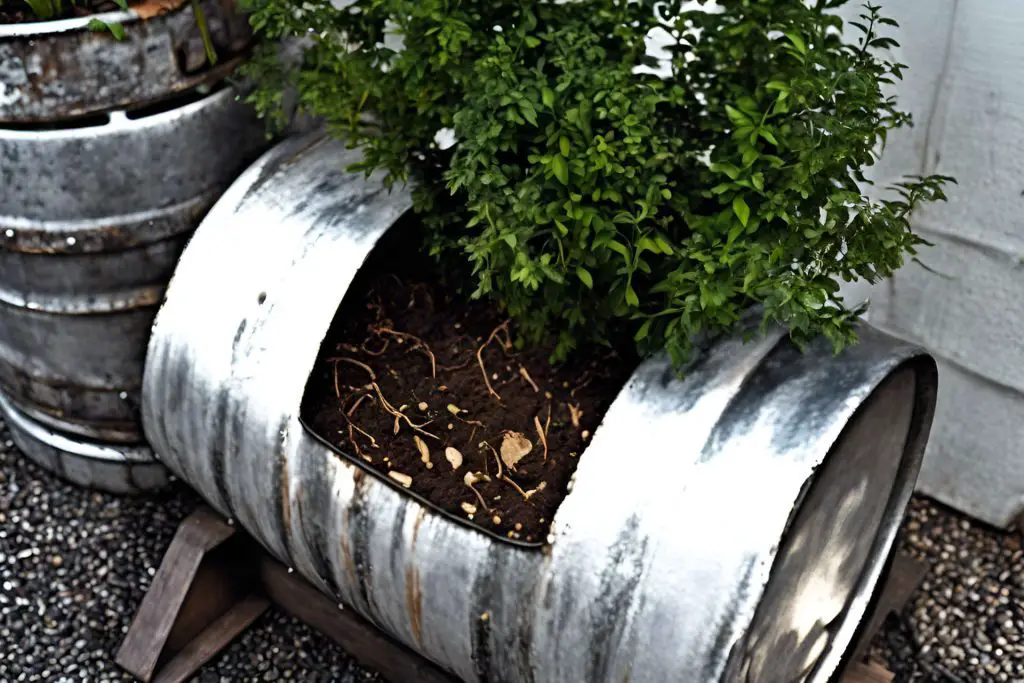Innovative Planting Spaces: The Beer Keg Raised Garden Bed
Gardeners are continually seeking innovative and sustainable ways to grow and cultivate plants, even in limited spaces. One such creative solution involves repurposing an old beer keg into a raised garden bed. This approach not only recycles materials but also adds a unique aesthetic element to gardens and patios. By positioning the keg horizontally and supporting it with a wooden frame, gardeners can create an efficient and attractive raised bed perfect for various plants.
Advantages of Using a Beer Keg for Gardening

A beer keg make a great raised garden beds as they are made from durable materials, typically stainless steel, which can withstand harsh weather conditions without rusting or deteriorating. This durability makes them an excellent choice for outdoor garden projects. A further benefit is that the metal of the keg can help regulate soil temperature, warming up quickly in the sun and retaining heat during cooler periods, which can extend the growing season.
A keg’s size and shape is another advantage. When positioned horizontally, the cylindrical shape provides a decent size surface area for planting, while its depth is ideal for root development. The raised aspect of the keg garden ensures good drainage and reduces the risk of soil compaction, promoting healthier plant growth.
Sourcing an Old Beer Keg for Your Garden Project
Finding an old beer keg for your garden project can be an adventure in itself, offering opportunities to explore various venues. One of the most straightforward places to start is local breweries or pubs. Many establishments are willing to sell or even give away old kegs that are no longer in service. It’s a good idea to establish a friendly relationship with local business owners, as they can often offer insight into handling and repurposing the kegs.
Another excellent resource is restaurant supply stores or businesses that specialize in used food and beverage equipment. These places often have kegs that have been retired from commercial use but are still perfectly suitable for gardening projects. Online platforms such as Craigslist, eBay, or Facebook Marketplace are also valuable for finding used kegs. Sellers often list old kegs at reasonable prices on these sites, and you can occasionally stumble upon a free giveaway.
For those who prefer to see items in person before purchasing, scrap yards or metal recycling facilities can be promising spots to check out. These facilities often have kegs that have been discarded and are available for purchase by the pound, which can be a cost-effective option. When visiting these places, it’s essential to go prepared with the right tools to check the keg’s condition, ensuring it’s suitable for your gardening needs.
Upcycling Your Beer Keg to a Raised Garden Bed
Now you have got hold of a keg, the first step in transforming a beer keg into a garden bed is to prepare the keg by cleaning it thoroughly to remove any residues that could harm plants. The next step involves cutting the keg lengthwise, creating a large opening that will serve as the planting area. It’s crucial to smooth any sharp edges for safety and to drill several drainage holes along the bottom side of the keg.
Supporting the keg with a wooden frame is essential for stability and ease of access. The frame elevates the keg, making it easier to tend to the plants without bending excessively. This setup is particularly beneficial for those with mobility issues or limited space. The wooden frame can be built using weather-resistant wood like cedar or redwood, which ensures longevity and complements the metallic sheen of the keg.
Selecting Soil and Plants for Your Keg Raised Garden Bed

Filling your beer keg garden with the right soil mix is critical for plant health. A mixture of potting soil, compost, and perlite provides excellent aeration and nutrient balance, ideal for container gardening.
Choosing Plants
When it comes to choosing plants, the options are varied. Herbs, flowers, and small vegetables like lettuce or spinach are perfect for keg gardens due to their shallow root systems.
For those looking to add more diversity, small root vegetables or even strawberries can thrive in the deeper central parts of the keg, utilizing every inch of space efficiently.
Planting Ideas:
- Plant nitrogen-fixing legumes, like beans or peas, to naturally enrich the soil.
- Interplant complementary herbs, such as basil and tomatoes, to enhance growth.
- Consider companion planting, like placing marigolds among tomatoes to deter pests.
- Harvest your crops at the appropriate time, ensuring maximum flavor and nutrition.
Watering and Maintenance Strategies
Effective watering is key to successful keg gardening. Since metal heats up more quickly than other materials, monitoring moisture levels to prevent drying out is crucial. Installing a drip irrigation system or using a watering wand can help provide deep, even watering that encourages robust root growth without waterlogging the soil.
Regular maintenance tasks such as weeding, trimming, and checking for pests will keep your keg garden healthy. The elevated and contained nature of the keg garden may help deter some pests and diseases, but regular inspections are still necessary to catch any potential issues early.
Integrating Beer Keg Gardens into Indoor Spaces
Repurposing an old beer keg into a raised garden bed doesn’t have to be limited to outdoor spaces; it can also bring a unique touch of greenery to indoor environments such as home offices or retail settings. Incorporating plants indoors has been shown to improve air quality, enhance mood, and increase productivity, making a beer keg garden a practical and stylish addition to any indoor space.
Home Offices
In a home office, a beer keg garden can serve as a dynamic focal point, adding life and color to the workspace. Positioning a small, horizontally cut keg under a window ensures the plants receive adequate light. Opt for low-maintenance plants like succulents, small ferns, or herbs that thrive indoors. Not only do these plants require minimal upkeep, but they also add a fresh scent and a touch of nature that can make work-from-home days more pleasant.
To integrate a keg garden into a home office effectively, consider using it as a natural room divider or placing it beside a desk to double as a functional piece of décor. It can also be used to soften the aesthetics of modern technology and office furniture, providing a pleasing visual contrast.
Retail Environments
In retail settings, a beer keg garden can enhance the customer experience by creating a more inviting and relaxed atmosphere. Placing a series of keg gardens throughout a store can lead customers on a natural journey through the space, making the shopping experience more enjoyable. Retailers can choose plants that align with their brand’s aesthetic or seasonally rotate plants to reflect sales themes or holidays.
Furthermore, a keg garden can be strategically placed to highlight certain products or areas within a store. For example, a lifestyle or home goods store might use lush foliage to complement home décor items, or a bookstore could use calming herbs to create a serene reading nook.
Customization and Care
When adapting beer keg gardens for indoor use, it’s important to tailor the setup to ensure the plants receive sufficient light. If natural light is limited, installing grow lights above the kegs can provide the necessary energy for plant growth. Additionally, choosing a potting mix suited for indoor plants will help prevent common issues like mold or pests.
In both home offices and retail environments, the key to successfully integrating beer keg gardens is maintaining the health of the plants with regular watering, pruning, and monitoring for indoor-specific pests. By doing so, these unique planters not only serve their primary function but also contribute to a healthier and more inviting indoor environment.
Community and Environmental Impact
Repurposing an old beer keg as a garden bed is not just about gardening; it’s also a statement about sustainability and creativity. This project can inspire others in your community to think differently about what can be repurposed into useful garden features. Schools, community centers, and even small businesses can adopt this idea to transform their spaces, promote green living, and engage in environmental education.
Final Thoughts
A beer keg raised garden bed is not only a creative ways to convert old metal into lush garden beds but provides a practical, environmentally friendly approach to urban gardening. It is a project that should appeal to both gardeners and DIY enthusiasts as converting a beer keg into a garden bed provides an opportunity to grow your plants while upcycling with style. Embrace this novel gardening method and watch as your garden becomes a focal point of conversation and a source of pride.
